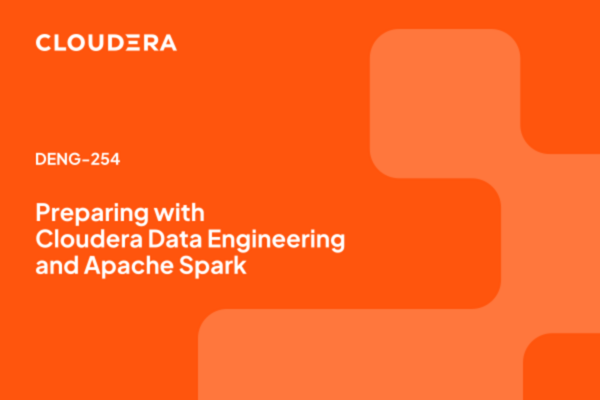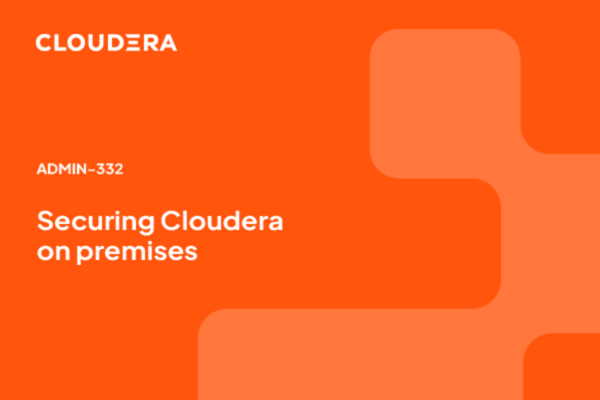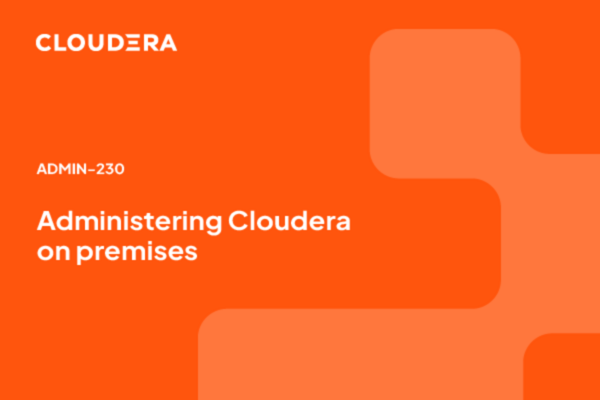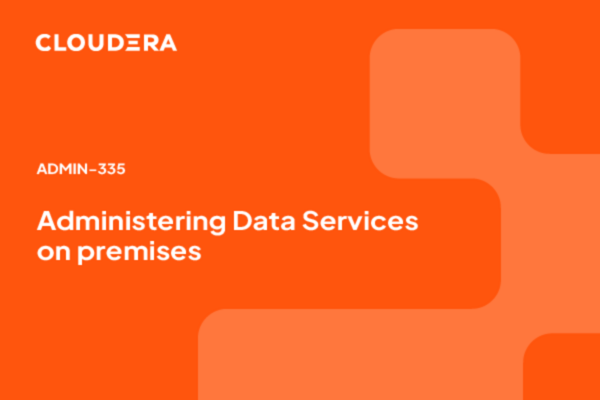Upcoming Sessions
-
November
24
ILT - ADMIN-332: Securing Cloudera on premises - 4676378
Starting:2025/11/24 @ 09:00 AM ParisEnding:2025/11/27 @ 05:00 PM Paris -
November
24
ILT - Cloudera Custom Training - 4759955 - Admin-238 - Administering Kubernetes - EMEA
Starting:2025/11/24 @ 09:00 AM BerlinEnding:2025/11/28 @ 05:00 PM Berlin
See All Upcoming Sessions

This four-day hands-on training course delivers the key concepts and knowledge developers need to use Apache Spark to develop high-performance, parallel applications on the Cloudera Data Platform. Hands-on exercises allow students to practice writing Spark applications that integrate with Cloudera Data Platform core components. Participants will learn how to use Spark SQL to query structured data, how to use Hive features to ingest and denormalize data, and how to work with “big data” stored in a distributed file system. After taking this course, participants will be prepared to face real-world challenges and build applications to execute faster decisions, better decisions, and interactive analysis, applied to a wide variety of use cases, architectures, and industries. Download full course description What you'll learn During this course, you will learn how to: Distribute, store, and process data in a cluster Write, configure, and deploy Apache Spark applications Use the Spark interpreters and Spark applications to explore, process, and analyze distributed data Query data using Spark SQL, DataFrames, and Hive tables Deploy a Spark application on the Data Engineering Service What to expect This course is designed for developers and data engineers. All students are expected to have basic Linux experience, and basic proficiency with either Python or Scala programming languages. Basic knowledge of SQL is helpful. Prior knowledge of Spark and Hadoop is not required. DATE: January 12-15, 2026 Virtual Classroom, EMEA 9:00 - 17:00 (GMT+2 TIMEZONE) Read more

Enterprise data science teams need collaborative access to business data, tools, and computing resources required to develop and deploy machine learning workflows. Cloudera AI, part of the Cloudera platform, provides the solution, giving data science teams the required resources. This four-day course covers machine learning workflows and operations using Cloudera AI. Participants explore, visualize, and analyze data. You will also train, evaluate, and deploy machine learning models. The course walks through an end-to-end data science and machine learning workflow based on realistic scenarios and datasets from a fictitious technology company. The demonstrations and exercises are conducted in Python (with PySpark) using Cloudera AI. Download full course description DATE: January 19-22, 2026 Virtual Classroom, EMEA 9:00 - 17:00 (GMT+2 TIMEZONE) Read more

The Cloudera platform is intended to meet the most demanding technical audit standards. The significant improvements in Cloudera architecture and components make Cloudera “Secure by Design.” This four-day hands-on course is presented as a project plan for Cloudera administrators to build fully secured Cloudera clusters. The course begins with implementing Perimeter Security by installing host level security and Kerberos. Next, students protect Data by implementing Transport Layer Security using Auto-TLS and data encryption using Key Management System and Key Trustee Server (KMS/KTS). Following this, in the third stage, students control access for users and to data using Apache Ranger and Apache Atlas. The fourth stage focuses on visibility practices, teaching students how to audit systems, users, and data usage. Finally, the course introduces Cloudera practices for Risk Management in a fully secured Cloudera platform. This course is 60% exercise and 40% lecture. DATE: November 24-27, 2025 Virtual Classroom, EMEA 9:00 - 17:00 (CET TIMEZONE) Read more

Cloudera is a fully integrated edge to AI product set. Cloudera Manager is purposely built as the DevOps tooling for building and managing the Cloudera platform. This four-day hands-on course presents detailed explanation, comprehensive theory, key skills, and recommended practices for successful platform administration. Upon completion of this course a Cloudera Administrator will learn the full range of functionality and capability of Cloudera Manager. DATE: December 1-4, 2025 Virtual Classroom, EMEA 9:00 - 17:00 (CET TIMEZONE) Read more

This four-day course teaches the architecture, deployment, and configuration of Cloudera Data Services on Embedded Containerized Services (ECS). Cloudera Data Services provide a state-of-the-art, low- code platform that unifies the entire data lifecycle, reducing development costs and accelerating the development and deployment of use cases. The course starts by covering best practices for managing Docker images and containers. Students will then build a Docker private registry. This Docker private registry will be used to deploy a Data Services cluster on ECS. Students will install, configure, and validate Cloudera Data Engineering, Cloudera Data Warehouse, and Cloudera Machine Learning. Through hands-on exercises, students will gain experience with Kubernetes, install a Private Cloud Embedded Container Service (ECS), and deploy Cloudera Data Services. Additionally, the course covers networking and hardware requirements and explains how Kubernetes pods dynamically scale to support Cloudera Data Services. Who should take this course This immersive course is designed for Cloudera Administrators transitioning to managing Cloudera Data Services on premises. Students should have at least 3 to 5 years of system administration experience. Students must have proficiency in the Linux Command Line Interface and knowledge of Identity Management, including Transport Layer Security and Kerberos. Familiarity with SQL select statements is recommended. Prior experience with Cloudera products is required. Students need reliable internet access to connect to the Amazon Web Services environment used in this course. Recommended prerequisite courses • ADMIN-230: Administering Cloudera on premises • ADMIN-332: Securing Cloudera on premises DATE: January 19-22, 2026 Virtual Classroom, EMEA 9:00 - 17:00 (CET TIMEZONE) Read more

The Cloudera platform is intended to meet the most demanding technical audit standards. The significant improvements in Cloudera architecture and components make Cloudera “Secure by Design.” This four-day hands-on course is presented as a project plan for Cloudera administrators to build fully secured Cloudera clusters. The course begins with implementing Perimeter Security by installing host level security and Kerberos. Next, students protect Data by implementing Transport Layer Security using Auto-TLS and data encryption using Key Management System and Key Trustee Server (KMS/KTS). Following this, in the third stage, students control access for users and to data using Apache Ranger and Apache Atlas. The fourth stage focuses on visibility practices, teaching students how to audit systems, users, and data usage. Finally, the course introduces Cloudera practices for Risk Management in a fully secured Cloudera platform. This course is 60% exercise and 40% lecture. DATE: January 5-8, 2026 Virtual Classroom, EMEA 9:00 - 17:00 (CET TIMEZONE) Read more
Shopping Cart
Your cart is empty
